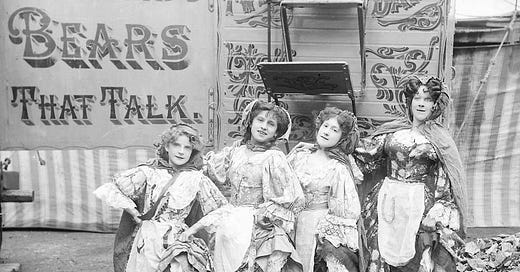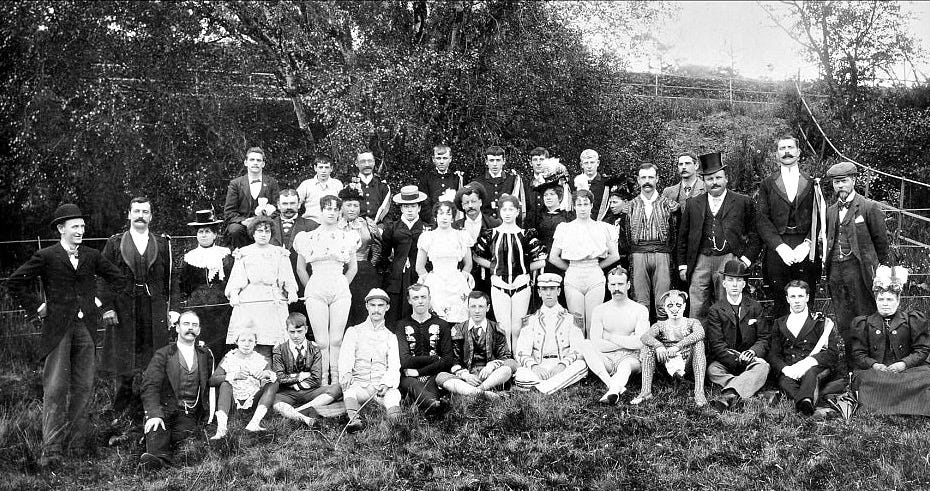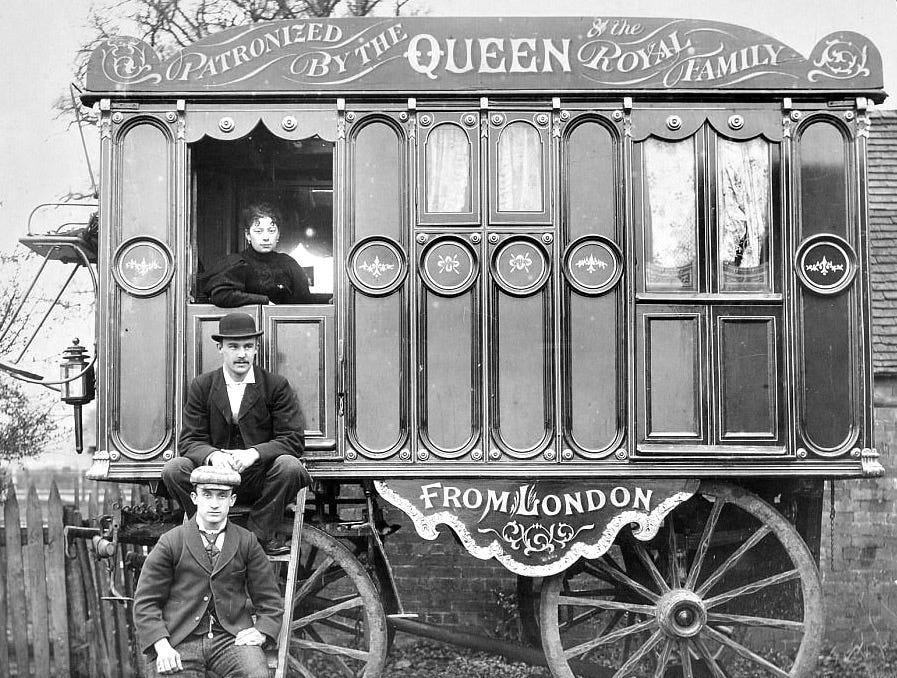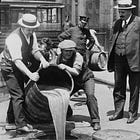The Show Must Go On: A Circus Story of Motherhood and Resilience PART 1
The remarkable tale of Blanche Pouche Leon
Release Date: February 18, 2025
The fairyland of youth
Then there is the circus ring, with its odor of freshly spread saw dust; with its lemonade vendor and disposer of minstrel tickets; with its clowns and ringmasters, its acrobats and wonderful equestrians, crowds of people sitting in circular rows one above the other, and its gorgeous, upholstered horses prancing in proud consequence.
Ah, this is the fairyland of youth. Here are the sights never to be forgotten. Here are the faces that are to be photographed on memory’s tablet. The boys press close to the ring, willing to risk the danger of a horse breaking loose upon them rather than miss the slightest movement or the least word of the performers. To them the jokes are all new; to them the armor of the knights is real silver and steel and the trappings true gold; to them the music of the band hath no false notes, but is fill of delicious inspiration, and as they drink it all in, their dear hearts are fired and they resolve that when they are older, circus-men they will be. 1
The circus comes to town
Not a lot is known about Blanche Pouche’s early life. According to her own words, she was born outside of Madrid, Spain, in or about 1848. Who her parents were, whether they were peasant farmers, craftsmen, traders, or members of the Cortes Generales is unknown.
What is known, however, is that sometime during the spring of her 13th year, Blanche attended a circus – likely the Royal Spanish Circus under the direction of prominent circus director Giuseppe Chiarini – and she fell in love.
How could she not?
Held under a large tent in a local park, the circus featured elaborate equestrian acts – death-defying stunt riding and equestrian ballet, which saw riders, often young girls like herself, guide their spirited Andalusian horses through synchronized routines that included circles, figure-eights, and zigzag patterns to the soaring notes of the local musical style, La Zarzuela.
There were acrobats who performed fast-paced, physically demanding, and highly theatrical feats combining strength, balance, and agility. Some performers balanced on canes, pedestals, or even galloping horses. Others astonished the crowds with an act called Rolla Bolla, balancing on a board atop stacked rolling cylinders.
Gymnasts and so called “ground acrobats” performed daring combinations of somersaults, flips and one-arm balances on small pedestals. They jumped over barrels and poles and even each other and formed human pyramids, often six, seven or even eight tiers high.
There were tightrope walkers who accomplished breathtaking feats on a thin rope stretched between two poles and high above the ground. Without a safety net, they did backward somersaults and balanced chairs and trays of glasses as they made their way from one side to the other, and even crossed the rope blindfolded and on stilts.
And amid all this excitement and chaos, there were the clowns.
Aristocratic white-faced clowns in ruffled collars and elegant silk costumes; bumbling and mischievous clowns with big red noses, oversized clothes, and clumsy shoes causing trouble; creepy grotesque clowns, clueless country bumpkin clowns dressed in peasant clothes, with straw hats and raggedy shirts, and melancholy tramp clowns who chased butterflies and sometimes brought audience members to tears.
At some point during the performance, Blanche’s attention was drawn to one of those clowns. Captivated.
Maybe their eyes met and held. Maybe he brought her a flower. Maybe he smiled, and she offered a shy smile in return.
Sometime later, maybe that very night, Blanche came face to face with her destiny.
His name was Joseph. Joseph Leon, and before the year was over, Blanche would be his wife.
Please hit the ❤️ button at the bottom of the page to help this story reach more readers. And if you’re not already a subscriber, I’d love to have you join me. Thanks!
Regarding the women of the circus
Of the women that enter the profession, their origin is not always certain, but a majority of them are born into the business and known nothing outside of it. There are few notable exceptions, but perhaps the majority of them are women of only ordinary mental attainments and peculiarly exclusive lives, however contrary to common opinion that may seem.
Until they are married, and that is genuinely very early in life, they are almost invariably accompanies by their fathers, brothers or mothers, whose surveillance is usually very strict.
Ladies who ride or perform daring feats look down upon members of their own sex like pretty Montague, who are not acrobats. They declare that such ladies ‘have no talent’. A woman born pretty is regarded by them in the same sense as a woman born with a beard or no arms – merely a curiosity.
Circus people seldom care to make acquaintances outside of their business. This applies particularly to the women. Knowing that they are not regarded as a class in as fair a light as they should be, they return the same sort of distrust, and outside of their most intimate family friends hardly know nor trust anyone.
Perhaps to emphasize this fact, I can cite an instance in my own experience which included some thirty women, and, although I stood close to the management, my acquaintance with the women was never more than the ordinary exchange of salutations except with two, and they were both married ladies and old enough to be my mother.
Public opinion concerning circus women is almost entirely erroneous and does them the grossest injustice, although this opinion derives its origin from the very exclusiveness the women depend upon for their protection. The public knows circus people as being all of one kind and class, when, in truth, there is as much diversity among them as is possible to conceive in a like number of people banded together in any other calling.” 2
The Young Bride and the Big Top
Before her marriage to 15-year-old Joseph, Blanche had a fairly simple life. She lived at her parents' home and was surrounded by family, extended family and people she'd known her whole life – most of whom were just like herself. Daily life had a stable, predictable rhythm – Blanche helped with household chores, spent long hours sewing and mending, maybe caring for younger siblings, tending to livestock or even helping with her family's business.
That predictability carried over, in many ways, to the seasons: spring cleaning and planting, summer tending, fall harvesting and putting up food, and winter preparing for the coming spring. Year in, year out. Rhythm.
When she married Joseph, everything changed.
The circus to which Joseph was attached set up and remained in one place for longer periods than many other European circuses, and certainly longer than their American counterparts, but it was still far from the permanent settled existence to which Blanche was accustomed.
As newlyweds, she and Joseph likely boarded with various local families or at a public house near where the circus was set up, however, it's possible they shared a tent on-site, or even a carriage or wagon set aside for sleep and housekeeping, but which provided little privacy for the young couple.
Their meals were communal and served on a schedule convenient to performers and others who often worked late into the night, and the choice of foods changed by the day, depending on the availability of ingredients, where the meals were made, and by whom.
When the circus was moving, whether by ship, rail or wagon, Blanche and Jospeh would have experienced long, grueling days of travel, and nights out under the stars or in close quarters with other members of the circus.
When the circus was in residence, however, every minute of every day was consumed by the business, and busy-ness, of circus life.
For Joseph, that meant rigorous physical training, practicing and watching. New to circus life, he probably hadn't solidified his unique clown persona yet, so that would have been a top priority. Still, as a member of the clown troupe, Joseph played many other roles, maybe pairing with older, more experienced performers in skits or stunts or going into the crowd to engage audience members. He also could have been part of other acts — maybe even the human pyramid. Whatever role Joseph played under the big top, however, it would have required intricate timing, teamwork and his full attention.
For her part, Blanche's days were filled apprenticing with other women in the troupe, particularly those who oversaw the making and repairing costumes. Every performer had a set of costumes made of luxurious but fragile fabric — silks, satins, and velvets — many of which were adorned with intricate beading or embroidery which made them especially vulnerable to damage during physically demanding performances. Keeping the costumes in good order would have been an important job and likely forced Blanche to quickly master the sewing and mending skills she'd learned back home in Spain.
It would also have allowed her to adapt to the many multinational and multilingual aspects of her new home in a slower and more immersive way.
It’s not hard to imagine how overwhelming those early days in the costume tent must have been for her. Circus people came from all over the world, bringing with them different social norms and rules, traditions and expectations, and speaking in what must have seemed to Blanche, at least initially, a dizzying array of languages. Yet, word-by-word, stitch-by-stitch and day-by-day, she learned about and assimilated into her new circumstances.
Blanche forged bonds and grew friendships and became a trusted and valued member of the troupe.
And she came to rely on the other women of her circus family, something she’d be doing a lot of in the difficult days, weeks and years ahead.
Copyright 2025 Lori Olson White
Please hit the ❤️ button at the bottom of the page to help this story reach more readers. And if you’re not already a subscriber, I’d love to have you join me. Thanks!
JUST A QUICK NOTE: Last Tuesday, I floated the idea of adding a more newsletter-y section to the bottom of these weekly posts. In speaking with a lot of you, I’m pulling back on that idea and keeping this Tuesday post all about the Lost & Found stories.
I’m still intrigued with the idea — and potential value to all of you — of sharing insights, good reads, upcoming events and stories, and other information on the fringes of this publication.
One option I’m considering, and which has been suggested by several of you, is to share that stuff in a weekly chat. Look for that trial balloon later this week, and, as always, I’d love to hear your thoughts and ideas on this wee expansion of The Lost & Found Story Box. Thanks!
IF YOU’RE NEW HERE, I invite you to check out Call Me a Bastard, a my longest serialized story to-date, and the one that started it all here on the Lost & Found Story Box. I’ve added a link to Chapter 1 which introduces you to Aimee Henry and Mary Martha Parker.
AND IN CASE YOU MISSED IT, here’s a link to my most popular short series to-date, The Incorrigible John George. I hope you’ll agree that “incorrigible” is the best way to describe this old scoundrel!
The Lost & Found Story Box is reader-supported. When you buy through links on our site, we may earn an affiliate commission.
End Notes
1 Here We Are Again: Recollections of an Old Circus Clown, by Robert Edmund Sherwood, Bobbs Merrill Company. Indianapolis.,1926, P. 38.
2 “Old John’s Promises”, Richmond Dispatch, Richmond, VA, August 27, 1881, P. 1.











This is so beautifully written Lori. Your descriptive narrative gives me a very vivid picture of the life of a circus performer. I love your description of the women of the circus. Looking forward to Part 2.
What a wonderful narrative. It’s as if you were there, covering the circus, and also these two young performers who became a couple. Married at 15! So young and also worldly (at least in terms of travel).